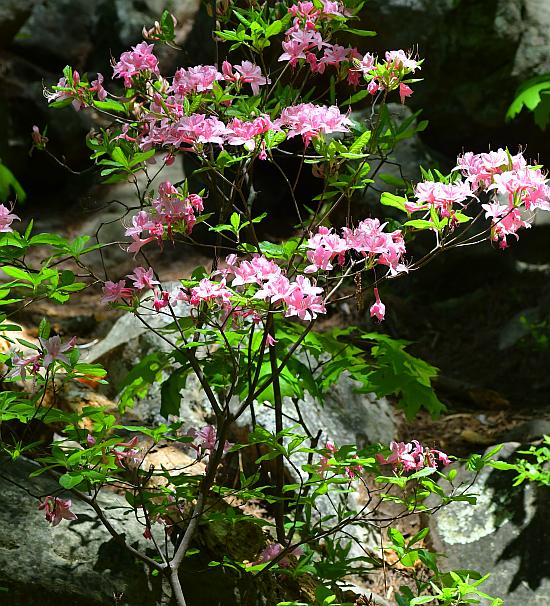Rhododendron prinophyllum (Small) Millais
Mountain Azalea

Native
CC = 8
CW = 5
MOC = 17
© SRTurner
Rhododendron prinophyllum (Small) MillaisMountain Azalea | |
 |
Native CC = 8 CW = 5 MOC = 17 |
© SRTurner |
|
Family - Ericaceae Habit - Shrubs or small trees 0.8-3.0 m tall, not colonial. Stem - Bark dark gray, often becoming scaly with small plates. Twigs densely and often minutely hairy, reddish brown, becoming brown to dark gray, the winter buds ovoid, with several overlapping scales, these sparsely and minutely hairy on the outer surface.
Leaves - Alternate but tending to be clustered near the branch tips, short-petiolate. Leaf blades 4-9 cm long, 2-4 cm wide, ovate to obovate, the margins entire and short-hairy, sparsely hairy on both surfaces, the main veins of the undersurface densely hairy.
Inflorescences - Short, umbellate racemes of 4-13 flowers, appearing before or with the leaves.
Flowers - Slightly zygomorphic, hypogynous, fragrant. Calyces deeply 5-lobed, 1.0-1.5 mm long, the lobes rounded to bluntly pointed at the tip, densely glandular-hairy. Corollas trumpet-shaped, the tube 1.2-1.8 cm long, the flaring to spreading lobes 1.1-1.6 cm long, rosy pink, the outer surface moderately to densely glandular-hairy. Stamens 5, exserted, the filaments 4.0-4.5 cm long, arched upward, hairy toward the base, the anthers tiny, ovate, lacking tubes or awns at the tip, dehiscing by 2 terminal pores. Ovary superior, densely glandular-hairy, with 5 locules, the placentation axile. Style 4-6 cm long, arched upward or slightly S-shaped, exserted to slightly beyond the stamens, mostly not persistent at fruiting, the stigma obconic to disk-shaped, shallowly 5-lobed.
Fruits - Capsules 10-14 mm long, 3-5 mm wide, narrowly oblong-ovoid to cylindrical, sparsely to densely glandular-hairy, dehiscing longitudinally from the tip along the sutures. Seeds 2.0-3.5 mm long, 0.6-1.0 mm wide, irregularly ovate to elliptic, strongly flattened and irregularly winged, the wing more or less entire at the tip and more or less fringed or dissected at the base, the surface more or less smooth, yellowish brown to light brown, shiny. Flowering - April - May. Habitat - Mesic upland forests and ledges of bluffs, mostly on north-facing exposures and acidic substrates. Origin - Native to the U.S. Lookalikes - None when flowering. Other info. - This attractive shrub occurs in a band through parts of the Missouri Ozarks, extending down into Arkansas and slightly into Oklahoma. A separate disjunct population is found in the northeastern U.S. It has a distinct preference for good quality habitat and acidic soils. The plant is easy to recognize when in bloom by its large pink flowers, which closely resemble nothing else in the state. The vegetative habit is also distinctive, with leaves which are often obovate (widest above the middle) clustered near the stem tips. Photographs taken at Pickle Springs Natural Area, Ste. Genevieve County, MO, 5-11-2020 (SRTurner). |